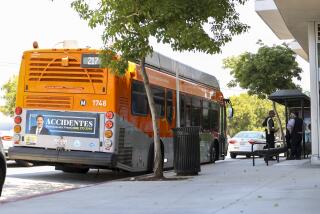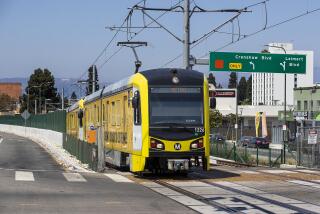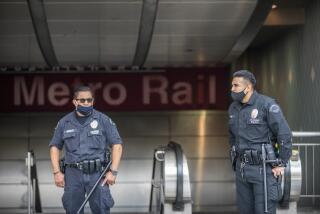Valley Stands to Gain From Independent Transit Zone
- Share via
A new study has confirmed that a stand-alone transit agency in the San Fernando Valley can provide customers with a better, more responsive and less costly system than is currently provided by the MTA.
In June, a coalition of nine Valley cities and Los Angeles County joined in exploring the wisdom and viability of an independent transit zone serving its public transportation customers. Many of us believed that such an entity made sense. We believed that a new transit agency dedicated exclusively to serving the Valley would be a significant improvement.
Opposition grew from those who felt that their interests would be best served by maintaining the status quo. Unions representing the Metropolitan Transportation Authority’s bus drivers and mechanics fought hard against establishing such a zone, fearing that cost savings would come at the expense of employees who might be forced to work for lower compensation and fewer benefits than their MTA contract provides. These unions persuaded the state Legislature to pass, and Gov. Gray Davis to sign, a bill to protect their workers’ labor contracts from erosion by any new zone.
As a result of this legislation and the new labor agreement reached after the recent monthlong MTA strike, the Valley Transportation Zone Interim Joint Powers Authority conducted a study to determine if an independent transit zone in the Valley remained viable.
We have our answer: Our consultants have concluded that a stand-alone zone would indeed be feasible under all but the most pessimistic scenarios.
The Valley stands to benefit from a public transit agency governed by Valley citizens for Valley citizens.
Locally based transit is more responsive. The Valley makes up only 18% of the MTA’s service area and as a result is an afterthought on most transit decisions made at MTA headquarters downtown. Through an independent transit zone governed by a Valley-based board, this area would be the focus of all decisions to deploy, improve and expand service.
Locally based transit is more affordable. Under the most conservative financial assumptions, our consultants concluded that the Valley Transit Zone would operate at 16% lower cost than the MTA. The MTA spends $98.66 per hour to operate a bus; a Valley Transit Zone could do it for $82.59 per hour or less. Any savings could be plowed back into expanded service, reduced fares or a combination of the two.
The zone’s costs could be cut even further if we factored in the following assumptions not included in our consultant’s report:
* That fare box revenues would continue to grow on Valley bus routes.
* That projected savings from the new bus drivers’ contract with the MTA would indeed be realized.
* That a younger mix of employees would choose to work at the new Valley zone while the more senior employees would remain at the MTA.
* That scheduling and maintenance efficiencies would be realized. This could add up to $107 million in additional savings for the new zone over the next 10 years.
The zone’s new employees would be fully protected. We would expect the zone’s new employees to be drawn from the MTA’s ranks. Thanks to those legislative protections secured by the MTA’s unions, the new zone would honor existing labor contracts in their entirety. Although this should have alleviated any lingering union concerns about the zone, representatives regrettably have persisted in their opposition and cling to the status quo, one that demonstrably has ill-served Valley public transit customers.
*
Establishing an independent transit zone for the Valley would be a Triple Crown victory. It would be a win for the Valley because we would get a locally governed, locally based public transit system that would put Valley transit users first. It would be a win for the MTA, which would be freed of the burden of planning and operating transit lines in the Valley, a challenge that hardly has been a top priority. It also would be a win for county and Valley taxpayers who would get a far better return on their annual $1-billion transit investment.
The Valley Transit Zone board has authorized its consultants to start talks with the MTA to formally establish a stand-alone zone. The viability of this endeavor will be determined by the agreement negotiated between the two, which would be submitted to the MTA board for approval.
We owe it to public transit customers to give them the best, most dependable and most cost-effective service possible. We are poised on the threshold of just such an opportunity. Let us seize the moment and move forward.
More to Read
Sign up for Essential California
The most important California stories and recommendations in your inbox every morning.
You may occasionally receive promotional content from the Los Angeles Times.













